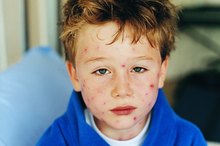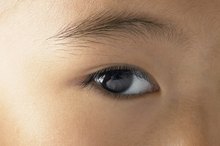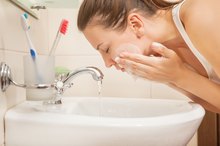What does fact checked mean?
At Healthfully, we strive to deliver objective content that is accurate and up-to-date. Our team periodically reviews articles in order to ensure content quality. The sources cited below consist of evidence from peer-reviewed journals, prominent medical organizations, academic associations, and government data.
The information contained on this site is for informational purposes only, and should not be used as a substitute for the advice of a professional health care provider. Please check with the appropriate physician regarding health questions and concerns. Although we strive to deliver accurate and up-to-date information, no guarantee to that effect is made.
What Are the Treatments for Chickenpox on the Scalp?
Since the introduction of an effective vaccine in 1995, chickenpox has become increasingly uncommon in the United States, according to the Centers for Disease Control and Prevention, or CDC. In most cases, the disease first strikes the trunk or face and then moves outward, affecting the scalp and extremities. Treatment for chickenpox of the scalp focuses on symptomatic relief and skin hygiene to reduce the risk of secondary bacterial infections. Some patients also require antiviral drugs.
Antiviral Drugs
According to University of Alabama Medical School Professor Richard J. Whitely in the 2008 edition of “Harrison’s Principles of Internal Medicine,” some individuals with chickenpox develop as many as 2,000 blisters while others—especially young children—may have fewer than 50 1. People with extensive disease and those categorized by the CDC as “high risk” for complications of chickenpox benefit from prescription antiviral drugs that reduce the severity and duration of symptoms 3. Common choices, says the Mayo Clinic website, include acyclovir, valacyclovir and famciclovir.
Topical Astringents
Causes of Itching on the Face and Neck
Learn More
In the 2008 edition of “Fitzpatrick’s Dermatology in General Medicine,” University of North Carolina dermatologist Craig N. Burkart explains that topical astringents reduce swelling, stop secretions and inhibit bleeding in people with chickenpox and other inflammatory skin conditions 2. Astringents used to treat acne are too harsh for chickenpox of the scalp. Whitely recommends over-the-counter aluminum acetate. The American Medical Association recommends a mixture of oatmeal and water. Applying a topical astringent one to three times per day during the early phase of the disease may help control irritation and accelerate healing.
- In the 2008 edition of “Fitzpatrick’s Dermatology in General Medicine,” University of North Carolina dermatologist Craig N. Burkart explains that topical astringents reduce swelling, stop secretions and inhibit bleeding in people with chickenpox and other inflammatory skin conditions 2.
- Astringents used to treat acne are too harsh for chickenpox of the scalp.
Good Hygiene
According to Whitely, good hygiene helps prevent secondary bacterial infections of chickenpox lesions, especially on the scalp where hair oils trap dirt and bacteria. Patients should wash their hair daily with mild shampoo, applying conditioner to the ends of hair only. People who normally use other hair products such as gels and sprays should refrain from doing so until chickenpox lesions are completely healed. Brushes and combs should be directed away from the scalp. Baths may be superior to showers. Soaking your scalp in tepid water during a bath, says Whitely, often provides relief from itching, superior even to medicated anti-itch lotions.
- According to Whitely, good hygiene helps prevent secondary bacterial infections of chickenpox lesions, especially on the scalp where hair oils trap dirt and bacteria.
Related Articles
References
- "Harrison's Principles of Internal Medicine, 23rd Edition;" A.S. Fauci et al.; 2008
- "Fitzpatrick's Dermatology in General Medicine, 7th Edition;" K. Wolff et al.; 2008
- MayoClinic.com: Chickenpox: Treatments and Drugs
- Centers for Disease Control. Chickenpox (Varicella): Transmission. Updated December 31, 2018.
- National Center for Biotechnology Information. Varicella Zoster (Chickenpox). Updated November 23, 2018.
- Centers for Disease Control. Chickenpox (Varicella): Prevention and Treatment. Updated December 31, 2018.
- Centers for Disease Control. Chickenpox (Varicella): Vaccination. Updated December 31, 2018.
Writer Bio
Heather Gloria began writing professionally in 1990. Her work has appeared in several professional and peer-reviewed publications including "Nutrition in Clinical Practice." Gloria earned both a Bachelor of Science in food science and human nutrition from the University of Illinois. She also maintains the "registered dietitian" credential and her professional interests include therapeutic nutrition, preventive medicine and women's health.








